ARTIFICIAL GROUNDWATER RECHARGE – Explanatory Guide
Compiled by Stanley Udegbunam || Nov 26, 2020
AFRILCATE
OVERVIEW OF ARTIFICIAL GROUNDWATER RECHARGE?
Groundwater is the largest source of freshwater for mankind and approximately 30% of the freshwater on Earth is groundwater.
In some rural areas, groundwater accounts for 100% of resident’s drinking water.
Groundwater is replenished naturally at a very slow rate. It can take several thousands of years for water to infiltrate the soil surface and percolate to the saturation zone.
In areas where groundwater is utilized faster than its natural replenishing rate, man-made recharge method becomes a necessary option for balancing the water levels.
This man-made recharge means is what is termed artificial groundwater recharge.
Artificial groundwater recharge is popularly called “artificial recharge”.
So for this guide, we’ll refer to artificial groundwater recharge as just artificial recharge.
Shortage of groundwater in an area will lead to depletion of aquifers and dryness of wells.
Its adverse effects will be felt both on the inhabitants and the environment.
WHAT IS ARTIFICIAL RECHARGE?
Artificial recharge is the process of increasing the amount of water that enters an aquifer through planned, human-controlled means.
Artificial recharge is different from the natural recharge means where precipitates like rainfall and snowmelt infiltrate the soil and percolate downwards to the water table without purposed human intervention.
Groundwater Recharge is the primary method through which water enters underground resources like the aquifer.
Aquifers are underground layers of rocks that hold the groundwater and they are found in the saturation zone.
A reduction in groundwater recharge rate will lead to a reduced amount of water stored in the aquifers which will negatively affect the ecosystem.
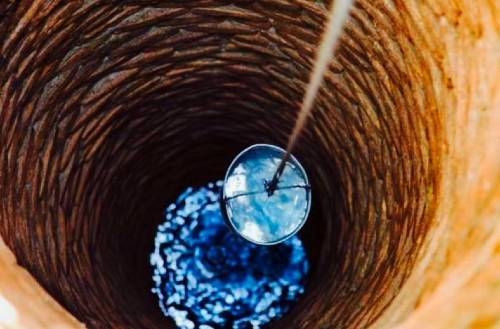
- when the natural recharge can’t balance water levels due to reduced availability of surface water.
- In areas where the consumption rate exceeds the natural recharge rate.
In the next sub-heading, we’ll look at the various methods in which aquifers can be artificially recharged.
METHODS OF ARTIFICIAL RECHARGE
Artificial recharge methods can be classified into two broad groups:
- Direct Methods
- Indirect Methods
- Surface Spreading Techniques
- Sub-surface Spreading Techniques
a. Surface Spreading Techniques
- Basins or percolation tanks
- Ditch and furrow system
- Stream augmentation
- Flooding
- Over irrigation
b. Sub-surface Techniques
- Injection or recharge wells
- Recharge pits and shafts
- Borehole flooding
- Dug well recharge
- Natural openings, cavity fillings.
- Induced Recharge
- Aquifer Modifications
- Groundwater Conservation Structures
a. Induced Recharge
- Pumping well
- Collector well
- Infiltration galleries
b. Aquifer Modifications
- Bore blasting
- Hydro fracturing
c. Groundwater Conservation structures
- Groundwater dams
- Fracture sealing
Of all techniques mentioned above, the most commonly used technique for the artificial recharge of groundwater is infiltration basins and Injection wells
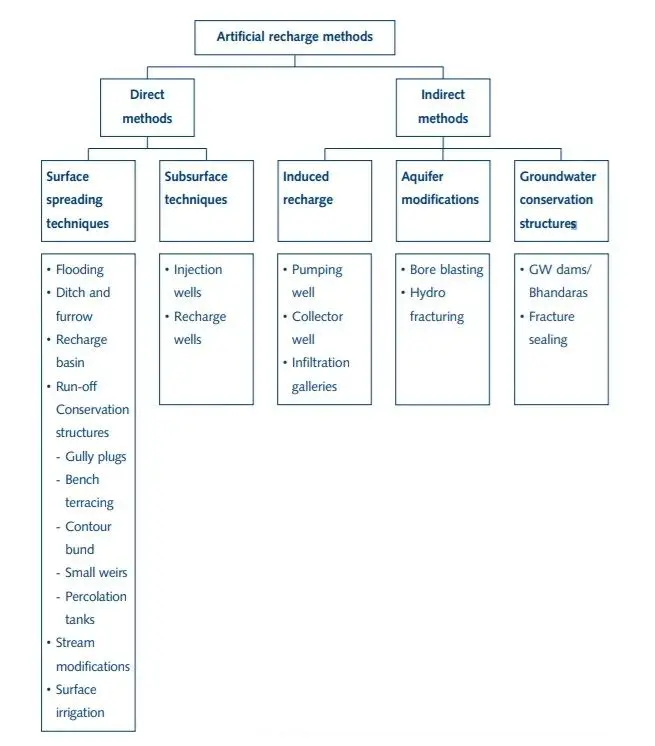
Artificial Recharge Methods
ARTIFICIAL RECHARGE STRUCTURES
Some man-made structures for the artificial recharge of groundwater include:
- Percolation tanks
- Infiltration Basins
- Dug Wells
- Recharge Shafts
- Injection Wells
1. Percolation Tanks
Percolation tanks are popular structures used for groundwater recharge.
The idea size of the percolation tank must be governed by its capacity of strata in tank bed.
Usually, percolation tanks are designed for storage capacities of 0.1 to 0.5 MCM and a ponded water column should be generally between 3 & 4.5m.
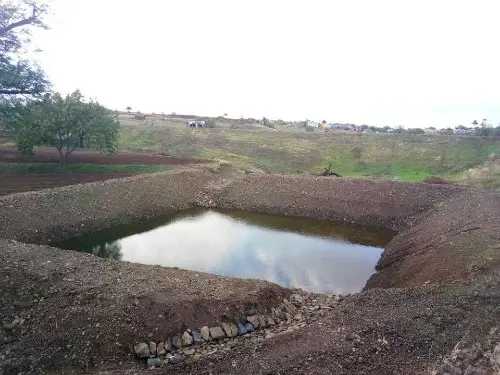
Percolation tank in Satara district in Maharashtra, India.
2. Infiltration Basins
These structures are used to recharge the groundwater reservoir both in loose soil as well as hard rock formation.
The efficacy and feasibility of this structure is higher in hard rock formation where the rocks are highly fractured and weathered.
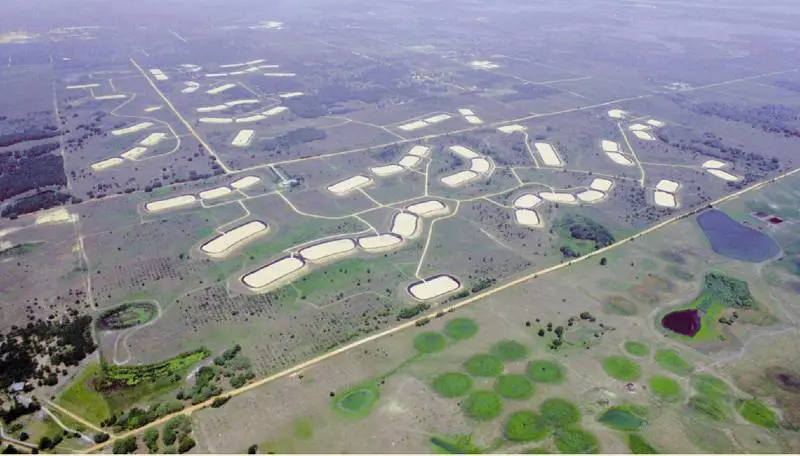
Rapid Infiltration basins, Orlando, Florida
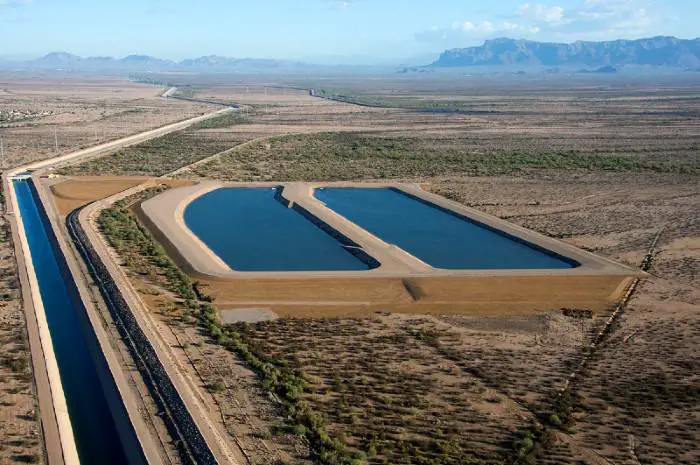
Phoenix–Avondale Water Partnership (to put colorado river into natural underground aquifers)
3. Dug Wells
In loose sediments as well as hard rock areas, there are thousands of dug wells that have either gone dry or the water levels have declined considerably.
These dug wells can be used as structures for artificial recharge.
The groundwater reservoir, stormwater, tank water, canal water, etc can be diverted into these structures to directly recharge the dried aquifer.

Dug Well Recharge
4. Recharge Shaft
This structure is very similar to a recharge pit but much smaller in cross-section.
Recharge shaft is used when the aquifer is located deep below the ground surface and overlain by poorly permeable strata.
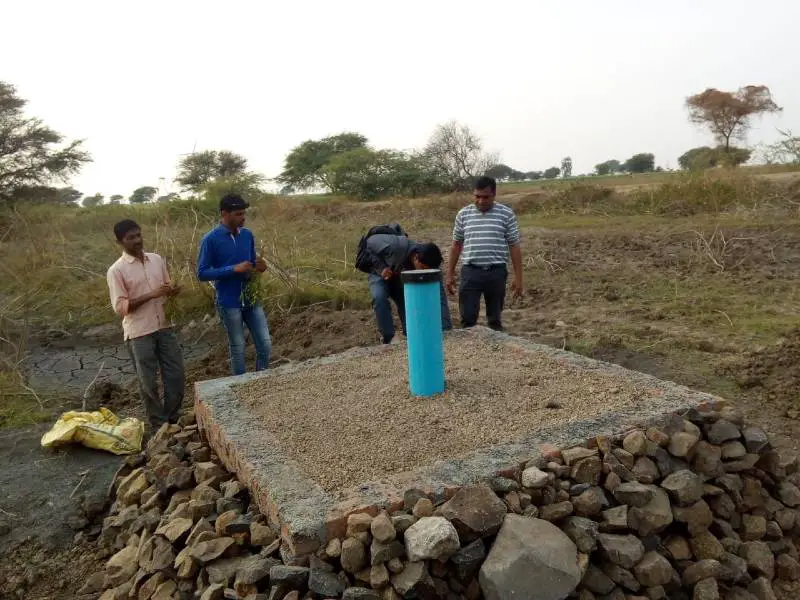
Recharge Shaft work at Gudarkheda village Ratlam MP for UNDP
5. Injection Wells
These structures are similar to a tube well but with the purpose of augmenting the groundwater storage of a confined aquifer by pumping in treated surface water under pressure.
The injection wells are advantageous when land is scarce.
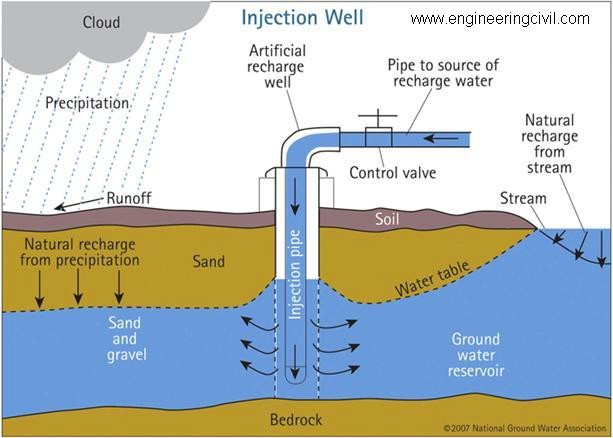
Dug well: image source – Engineering Civil
IMPORTANCE OF ARTIFICIAL RECHARGE
The importance of artificial groundwater recharge schemes are listed below:
- To augment the groundwater resources.
- To store the surplus surface water particularly during the flood periods for future uses and reduce the flood peaks.
- To retard the surface runoff resulting in lowering of flood peak, conserving the soil by reducing soil erosion and improving the soil moisture retention for a longer period in order to facilitate crop production and plant growth.
- To improve the quality of water stored.
- When the source water passes through the soil profile during the process of recharge, the soil mantle acts as a membrane to the travel of pathogens contained in the source water.
- To conserve the groundwater at the point of use. This is particularly suited to hard rock areas.
- To conserve thermal energy.
- To prevent saline intrusion in coastal aquifers.
DO YOU KNOW?
Soil Porosity and Permeability are two different soil characteristics that affect recharge rate.
Porosity refers to the amount of empty pore spaces within a given material.
While permeability is a measure of the ease with which a fluid can move through porous rock.
DO YOU KNOW?
Soil Porosity and Permeability are two different soil characteristics that affect recharge rate.
Porosity refers to the amount of empty pore spaces within a given material.
While permeability is a measure of the ease with which a fluid can move through porous rock.


I really appreciate this as a Hydrogeologist